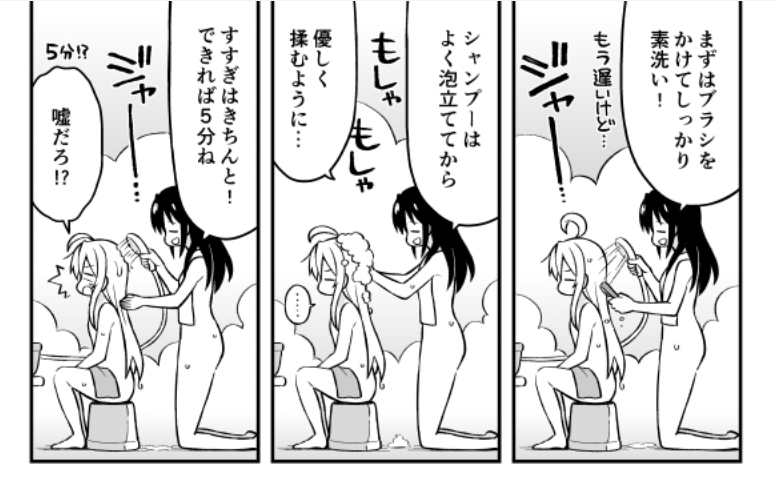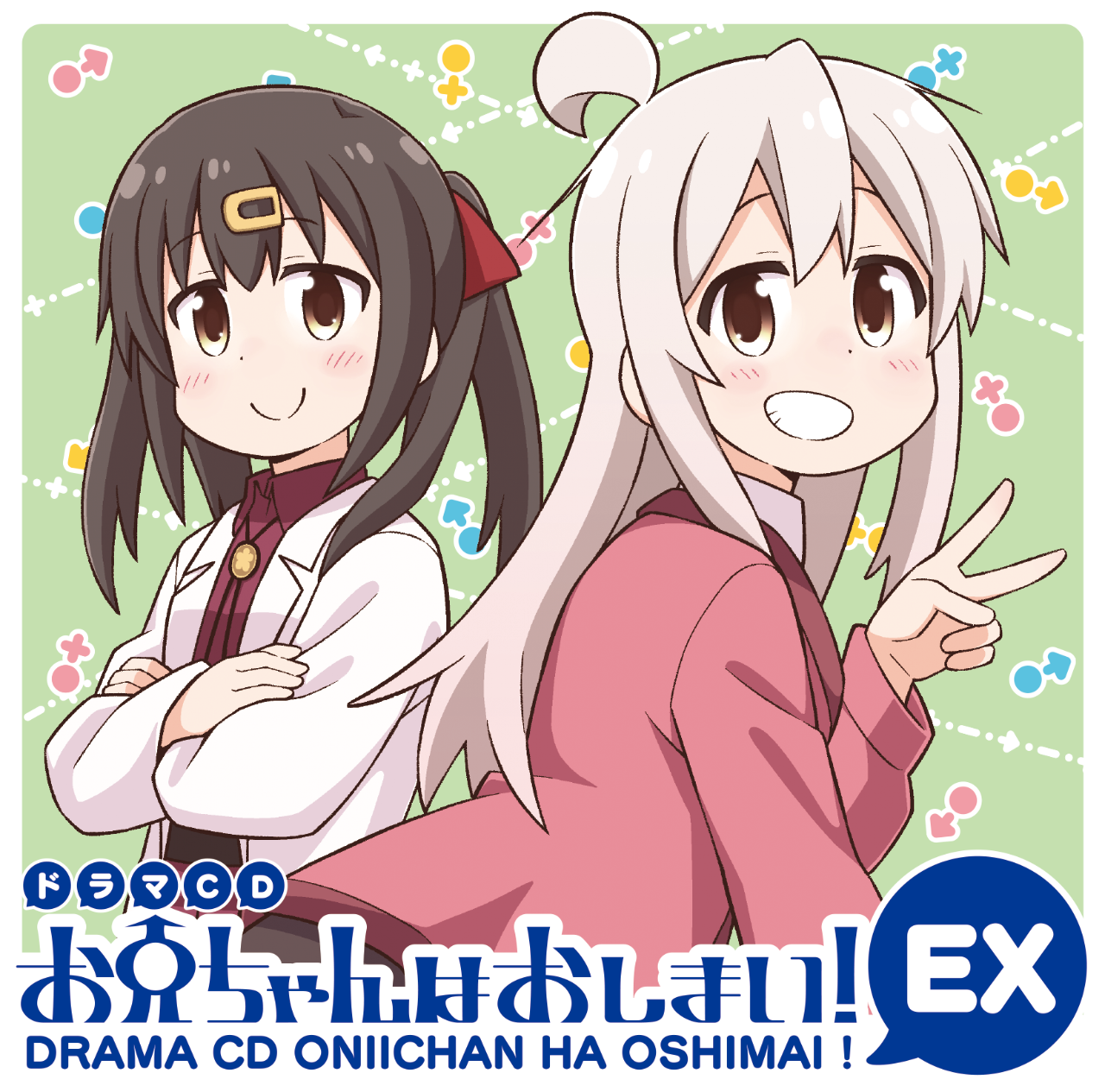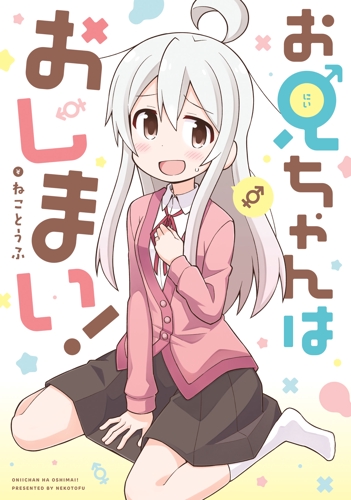アニメ会社に持ち込みも⁉ 『おにまい』原作者・ねことうふに聞く、オリジナルコンテンツの広げ方
インタビュー/阿部裕華
2023年1月から絶賛放送中のTVアニメ『お兄ちゃんはおしまい!』(以下、『おにまい』)。妹に飲まされた怪しい薬で女の子の体になった“元お兄ちゃん”の主人公・緒山まひろの日常生活を描いたほのぼのTS作品です。実は本作の原作はpixivの投稿から始まっており、そこから一迅社でコミックス化、雑誌「月刊ComicREX」で連載、アニメ化を果たしています。これほど商業展開をしている現在もなお、pixivで全話公開中、最新話の投稿も継続中です。
そこで今回は、pixiv投稿からアニメ化へと、作品が成長していった軌跡や、その時々でねことうふ先生が行っていたことをお聞きしました。
ねことうふ先生による漫画のオススメ回を紹介した記事はこちら!
得意の癒し系コメディに名作TS作品から得てきたエッセンスを合わせた
── ねことうふ先生は『おにまい』を描く以前から、性転換を描くTS作品がお好きとのことですが、どんな作品がお好きなのでしょうか?

── 『おにまい』は長らく温めてきた作品だったのでしょうか?

「いつかTS作品を描きたい」とずっと思っていたのですが、特に『おにまい』を温めていたわけではありません。『おにまい』を描く前に、もともとTS要素がある作品の二次創作同人誌を出したんですよ。TSものの美味しいところを詰め込むつもりで。
そうしたら評判が良く、オリジナルのTSマンガを考えるようになりました。ただ、いきなりオリジナル作品だとなかなか手に取ってもらえないので、まずはWEBでの投稿からはじめました。
── 投稿し始めてから手応えを感じるまでは早かったですか?

そうですね。WEBで公開している分、たくさん読んでもらったのはそうなんですけど、それを同人誌としてまとめて出した時に思いのほかよく売れたんですよね。そこでひとつ手応えを感じました。

── TS作品ですが、ほのぼの日常系なので初めての人でも触れやすいですよね。

昔からまったり癒し系コメディは得意な作風だったので、そこは変えずにお話を描いたところが受けたのかもしれません。『おにまい』でTS作品ファンの裾野が広がってくれると嬉しいですね。
── WEB公開だからこその工夫はありますか?

WEBで出すのであれば、まずはTwitterで一度に投稿できる4ページ以内でしっかり読者を掴むことが大事だと考え、第1話の1ページ目は「朝起きたら~」で始まるとても分かりやすい作りにしました。また、お話の内容次第でたまに前後編にすることもありますが、基本的には1話でオチが付いた方が読みやすいと思います。短めのページ数だと気軽に読めてなお良いです。1話終わるごとに新しいネタを考える必要があるのでなかなか大変ですが(笑)、結果的に読まれた理由のひとつではないかと感じています。
── テイストや形式はもちろん、女の子特有の悩みや今の中学生事情のリアルさも『おにまい』の魅力のひとつだと思うのですが、リアルにするためにしていることはありますか?

過去のTSの名作を一通り読んで吸収していた知識があるので、それらがマンガに反映されたところが大きいです。髪の毛を洗う描写の細かさなどは、美容師さんのブログなどを参考にして描きました(笑)。
「お兄ちゃんはおしまい その6」のワンシーン

中学生事情についても、あえて古い感じのままにすることもありますが、基本的には現代に寄せるようにしています。例えば、健康診断の話を描く際には、自分が中学生だった頃の健康診断が思い出せないので調べてみるんですよね。そうすると現在の健康診断との違いが分かることがあって。まひろの実年齢が高めなので、自身の中学時代とギャップがあるという話にも繋げられると思い、調べながら描きました。上手く構成できたのではないかと感じています。
「お兄ちゃんはおしまい その41」のひとコマ
WEBでファンが増えればおのずと売り上げはついてくる
── コミックスが発売され、雑誌掲載もされている現在も、pixivを含めたWEBでの無料公開や同人誌の発行を続けられています。商業活動と同人活動を並行しているのは、どのような理由があるのでしょうか?

一迅社さんからお声がけをいただき、商業単行本を出版することになったのですが、それはそれとして同人誌の収益も大きいんですよね。商業と並行して同人もやらせてもらえないかと相談したところ、ご快諾いただきました。これにはとても感謝しています。
とはいえ、現在は同人誌も20巻を超えており、そろそろどうしたものかと(笑)。でも、購入してくださる方もいるため、途中で急に終わらせるのも不義理と思い、続けています。
── WEBでの無料公開を続けていることについて、Twitterでも呟かれていましたよね。

これはちょっとカッコつけましたけどね(笑)。昔から、WEBでとにかく見てもらってファンの人が増えれば売上もついてくると分かっていたので、今でもそのやり方を踏襲しています。
今はWEBで公開したマンガを同人誌にまとめ、それを商業コミックスとして出版していただいているので、本来はもう少し時間をつくって同人誌限定のお話も描きたいなと考えているのですが、なかなかできていないところです。
── 同人活動に関しては、イベントへの出展だけでなく、月額制のファンコミュニティが運営できるFANBOXや、自家通販のBOOTHといったピクシブのサービスもかなり活用いただいている印象です。

── FANBOXを始めてみていかがでしたか?

始めてから3年間くらいはじわじわと登録者が増え続け、途中から横ばいになったものの、とても助かっています。
ここ数年は3ヶ月に1度のペースで『おにまい』の同人誌を出してますが、描き下ろし4ページくらい描いても、基本的にはWEBで公開しているお話の再録なんですよ。それを買ってくれる人って「作家を応援したい」と思ってくれている人ですよね。そういう読者さんと、FANBOXというサービスの相性がよかったのではないかと思います。
── クリエイター支援という点では、BOOTHにもブースト機能(商品の代金に好きな金額を上乗せして購入できる機能)がありますが、利用してくれるファンの方もいらっしゃいますか?

はい、思いのほかたくさんいらっしゃいます。たまにかなり大きな金額をブーストしてくださる方もいらっしゃって、そういう時にはちょっとしたおまけを付けたりすることもあります。BOOTHはそういうことが気軽にできるのでいいですね。ただアニメが始まってからは注文数が増えすぎてしまったので、このままだとヤバいです(笑)。
── すごい量を発送しなければいけないですもんね(笑)。クリエイターの方たちに向けて、FANBOX、BOOTHのオススメの活用法をお聞きできますか?

FANBOXはまだまだ手探りではあるのですが、一番安い100円の「応援プラン」は、『おにまい』最新話が1週間早く読めるような内容になっています。メインの300円の「もっと応援プラン」では、同人誌用描き下ろしマンガやイラスト、同人誌を作る上で副産物的に出てくるネームや設定画が見られるような感じです。最初はラフ画や昔のイラストを公開するなどしていましたが、手探りながらも今はプラン内容の適正価格を考えて活用しています。
BOOTHに関しては、送料が安くできるように活用していますね。また、在庫管理が苦手な方は倉庫サービスを活用すると気楽かと思います。僕は自分の手元にある在庫から減らしていきたいので、自分で管理していますが、そういうのも自分で選択できるのが便利ですよね。
制作会社、ディレクター、声優陣……縁と人に恵まれた同人ドラマCD
── BOOTHで販売されている『おにまい』の同人ドラマCDのクオリティの高さに驚かされました。

商業作品と全く差がないですよね(笑)。ディレクターを引き受けて下さった児玉拓己さんがとても熱意のある方で、すごくいいものを作っていただきました。2枚目のドラマCDでは、とあるご縁からFhána(※1)の佐藤純一さんに楽曲製作をご依頼したところ、同人作品なのに快くお引き受けいただいて。元々ファンだったのでとても嬉しかったですし、大変貴重な体験をさせていただきました。
(※1)Fhána
2011年、佐藤純一とkevin mitsunagaらが中心となり結成されたバンド。TVアニメ『有頂天家族』ED主題歌の「ケセラセラ」、『小林さんちのメイドラゴン』OP主題歌「⻘空のラプソディ」など、アニメの主題歌も多数手がける。公式サイト
第三弾となる「ドラマCD お兄ちゃんはおしまい!EX」。BOOTHにて販売中。
── そもそも同人ドラマCDを作ったキッカケは?

── 同人ドラマCDで、ねことうふ先生がやられた作業について教えてください。

僕は脚本づくりと収録の立ち会いくらいです。ディレクション的なことも多少させてもらったのですが、児玉さんがお芝居にすごく真摯な方だったのでほとんどお任せしました。
── キャストさんの選定もお任せだったのでしょうか?

基本的にはそうですね。キャラに合う声優さんをいきなり選ぶ自信が無かったので、まず何人か候補を出していただいて、そこから僕が個人的に好きな声優さんに決めさせていただいた感じです。
同人ドラマCDなのでオーディションはできなくて。いきなり現場で収録になるので一発勝負みたいなところがありますけど、みなさんプロなのですごくお上手で。児玉さんのディレクションのおかげもあり、とてもハマるキャスティングになったのではないかと思います。
── まひろ役の高野麻里佳さん、みはり役の石原夏織さん、かえで役の金元寿子さんらなど、ドラマCDからTVアニメへキャスト陣が続投しているのも珍しいですよね。

アニメで声優さんが変わることはよくありますよね。『おにまい』はキャラと声がピッタリ合っていましたし、何より同人ドラマCDという個人制作のコンテンツに出演していただいた恩もありましたので、アニメ制作時に「できれば同人ドラマCDの声優さんに続投いただきたいです」とお願いしました。
「同人の仕事ってどうなの?」と思われる事務所さんも多いと思うんですよ。なので、『おにまい』で同人ドラマCDからTVアニメに繋げる実績ができたのは、同人活動している方へのちょっとした希望にもなったのではないかと思います。
スタッフのこだわりをできる限り活かした、TVアニメ『おにまい』
── TVアニメ『おにまい』の制作は、『無職転生』でアニメファンの間で話題になったスタジオバインドさんですね。TVアニメ『おにまい』について、原作者としてどのように感じられていますか?

『おにまい』の企画段階では『無職転生』の最初のPVが出たくらいのタイミングだったので、スタジオバインドさんについて細かいことはまだよく分からなかったのですが、結果的にすごいスタジオで本当にありがたいです。自分の描いたキャラクターがあんなに自由に動いているなんてすごく感慨深いです。
── 動きの細かさはさることながら、全体の色味や画面端に映るトーンのようなドット模様など、画作りにもかなりこだわりを感じます。あれは制作側のアイデアなのでしょうか。

藤井慎吾監督のアイデアだと思います。以前監督が作られていたアニメーションPVも同じようなルックだったので。最初にデザインが上がってきた時、「この色合いだと目が疲れてしまうのでは」とちょっと議論になったんですよ。ただ、監督からは「普通の色味だと平凡なアニメになるので、これでいきたいです」と意見をいただきまして。少し調整はしていただきましたけど、ほぼ最初にご提案いただいたテイストで作ってもらいました。

── ねことうふ先生ご自身もTVアニメにかなり関わられているのでしょうか?

がっつり関わらせていただいています。実は今回のアニメ化の話が来る前、アニメ業界の友達の伝手を借りて、いろんな会社へアニメ化の企画を持ち込んでもらっていたんです。良い感触もあったのですが、当然ながら簡単には進まない上にコロナ禍にも突入し、アニメ化は正直難しいかなと思っていました。そんな中、アニメ企画会社のEGG FIRM(TVアニメ『おにまい』のプロデュースを担当)さんから一迅社さんにアニメ化のお声がけがありまして、お繋ぎしてもらい、企画から入らせていただきました。
── 持ち込みが直接つながったわけではないものの、自ら作品を広げていく動きがすごいですね。アニメ制作には具体的にどんな風に参加されているのでしょうか?

まず脚本会議に毎回参加し、キャラクターデザインやコンテなどのチェック、アフレコ立ち会い、版権イラストやグッズのチェックなど、一通りのことをやらせてもらっています。
── ねことうふ先生から意見をお伝えすることも?

脚本会議ではプロデューサーやスタッフの方たちから「脚本は1番大事だと思うので、どんどん発言してください」と言われ、色々な意見を出させてもらっています。主にチェックさせてもらったのは、キャラの口調や言い回しなどの部分でした。ストーリー構成や演出面などは監督や脚本家さんの案を優先し、僕からは「ここだけはどうしても」という部分の要望だけお伝えしました。
キャラクターデザインも僕からある程度要望は出しましたが、スタッフのみなさんのこだわっている部分が出てきたら、無理に変えずにやっていただきました。実力のあるスタッフが揃っているという話でしたので、気持ちよく進めていただけるようお任せした部分が多いです。
── みなさんのこだわりが功を奏し、かなり大きな反響がありましたね。

放送初日は、ずっとTwitterで「おにまい」とエゴサーチしていたのですが、コメントが多すぎて読めないくらい(笑)。まずはそこで反響の大きさを感じました。
また、DLsiteやBOOTHなどで同人誌の注文が急増しましたね。おそらく新規で買いにきてくださった方たちだと思うので、アニメの手応えを実感しました。
── 普段は基本的に1人でマンガを描かれているかと思いますが、今回アニメの制作に携わったことで、クリエイターとして何か新しい発見がありましたか?

普段はアシスタントも雇わず、自分でできることは何でもやりたい性格なんですよ。背景なども自分で描いているのですが、アニメ制作に携わったことで、デザインなど専門的な部分はプロの方にお任せした方がいいなと思いましたね。自分の中にない要素が加わって、作品が進化するのを感じました。
僕自身、アニメが大好きで、嘘だと思われるかもしれないんですけど、ここ20年くらい、放送されているほぼ全てのアニメを見ています。マンガを描きながらではありますが、基本的に最後まで全部見るんですよ(笑)。もちろん作品によって好き嫌いはありますが、その積み重ねは作家として武器になっているのかなと。今回、アニメ制作の裏側を知ることができたのは、アニメオタクとしてとても興味深かったですね。
空前の“みよちゃん”ブーム到来!?
── 『おにまい』が世に出てから、23年で6年が経ちました。描き続ける中で印象が変わったキャラクターはいますか?

「お兄ちゃんはおしまい その1」の1ページ。まひろに対してやや辛辣なみはり。
── アニメになって印象が変わったキャラクターはいますか?

あさひですね。アニメ#8はあさひがめちゃめちゃ活躍している回だったのですが、すごく楽しそうに動いていて。元々元気なキャラではありましたが、僕の想像を超えてきて、いい意味でちょっと印象が変わりました。
── あさひとみよのふたりはドラマCDではまだ登場しないキャラクターですよね。アニメ化に際してオーディションをしたのでしょうか?

── 描き続ける中でお気に入りになったキャラクター、またアニメでお気に入りになったキャラクターもそれぞれ教えてください。

メインキャラクターは全員お気に入りです。なのでそれ以外で考えると、脇役のクラスメイトたちが気に入っていますね。僕はちょっとギャルな2人組(長瀬みやこ&八坂まい)が好きですが、読者のみなさんからはなぜかいつも寝ている子(富士見ねむ)に人気があります(笑)。最初はモブキャラクターのつもりだった彼ら・彼女らも、当番回などを描いていくうちにお気に入りキャラクターになっていきました。
「お兄ちゃんはおしまい その43」のワンシーン。
香水をつけたみはりはクラスメイトから囲まれる。2コマめの右が八坂まい、左が長瀬みやこ。

── みよちゃんはTVアニメで出番が増えると思うので楽しみですね(笑)。最後に読者のみなさんへメッセージをお願いします。

同人誌からここまで大きな作品になり、アニメ化することができたのは、ファンのみなさんの応援のおかげだと思います。本当に感謝しています。
そしてアニメから『おにまい』を知った方には、マンガもぜひ読んでいただきたいと思います。アニメとは印象が異なるかもしれませんが、非常に読みやすい漫画だと思うので、1話あたりサクサク読めます。pixivで無料で読むことができるので、ぜひ読んでみてください。
第1話はこちらから!
一迅社にてコミックス発売中!
『お兄ちゃんはおしまい!』原作コミックス第 1 巻~第 7 巻、公式アンソロジーコミックス第 1 巻~第 3 巻が好評発売中!コミックスでしか読めない特別描きおろしも。
そして、コミックス第 7 巻 特装版特典のねことうふ先生による描き下ろし小冊子「お兄ちゃんはおやすみ!」は電子でもお楽しみいただけます!
☆TVアニメ大好評放映中☆
2023年1月5日(木)より毎週木曜日に放送・配信中!
AT-X 23:30~/TOKYO MX 24:00~/BS11 24:30~/ABEMA 25:00~
公式HPに記載の各種動画配信サービスでも毎週日曜日25:00~順次配信中です。













